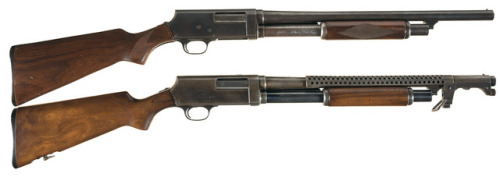historicalfirearms:Stevens Model 520 ShotgunThe Stevens Model 520 is one of John Browning’s lesser k
historicalfirearms:Stevens Model 520 ShotgunThe Stevens Model 520 is one of John Browning’s lesser known shotgun designs. Based on two patents filed in 1903 and 1906, Stevens bought the rights to the design and began production in 1909. The Model 520 is a ‘hammerless’, pump action shotgun with a bolt that locked into the top of the receiver, similar to one of Browning’s patents filed before the turn of the century. The Model 520 had a unique take-down barrel and locking breech block system which, once the slide was opened, the magazine tube could be unscrewed which freed the receiver from the barrel and magazine assembly. The position of the 520′s safety moved several times, initially inside the trigger guard, then moved behind the trigger guard on the left side and finally, with the Model 520A the safety moved to the shotgun’s tang. The Riot and later Trench Gun models had 20 inch barrels, 5-round tube magazines and weighed approximately 8lbs (3.6kg). Steven’s offered the Model 502 in various gauges, including 12, 16 and 20 gauge during its production run. A page from a pre-war Stevens catalogue showing two Model 520 sporting shotguns (source)With America’s entry into the First World War, the US military called for a trench shotgun. Stevens developed a military version of their Model 520, but the war ended before production began. While the US military did not purchase the Model 520 during the First World War, the Model 520-30 was purchased in large numbers during the Second World War. Fitted with a Henry Brewer’s patented heat shield and John Otterson’s sword bayonet mount for the M1917 bayonet. Production of the civilian Model 520 had ended before the outbreak of war and remaining guns were sold to the military before Stevens restarted production to cater to the war demand. The 520 had been superseded by the Model 620, in the late 1920s, which was little more than a streamlined version of the 520. Stevens intended the 620 to compete with contemporary streamlined designs like the Winchester Model 1912 and Remington Model 10. The military purchased both the 520-30 and 620A and the shotguns subsequently saw action during the Second World War, Korea and in Vietnam. Stevens produced 35,306 shotguns for the military during the war, of which 12,174 were M620As. Overall, Stevens produced just under 200,000 Model 520-pattern shotguns by the time production ended in 1955. Sources:Images: 1 2 3 4 5‘Magazine-Gun’, US Patent #781765, J.M. Browning, 10/07/1903, (source)‘Firearm’, US Patent #864609, J.M. Browning, 05/12/1906, (source)US Combat Shotguns, L. Thompson, (2013)War Department Technical Manual, Shotguns, All Types, Sept. 1942 TM 9-285, (source)If you enjoy the content please consider supporting Historical Firearms through Patreon! -- source link
Tumblr Blog : www.historicalfirearms.info




